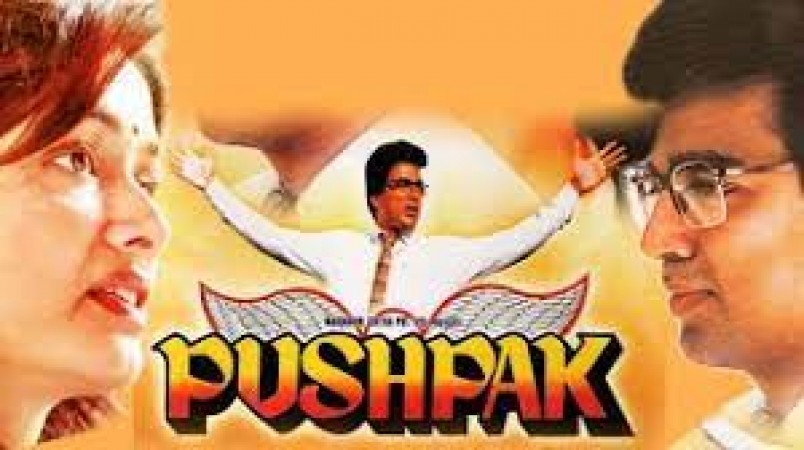
There have been films in Indian cinema history that not only enthralled audiences but also left their names in the history books for their eminent accomplishments. One such classic movie is "Pushpak Viman," which was helmed by Singeetam Srinivasa Rao. This 1987 silent, black-and-white classic managed to play for an incredible 273 days at the prestigious Sapna Theatre in Bangalore, India. In this article, we examine the elements that "Pushpak Viman's" improbable success and enduring legacy were fueled by.
In the Indian film industry, "Pushpak Viman," also known as "Pushpaka Vimana," is a singular and revolutionary work of art. It is a silent film in contrast to typical films, taking its cues from the period of silent cinema, which came before the introduction of sound in motion pictures. The film makes a bold departure from the dialogue-heavy films that have predominated Indian cinema by telling its story entirely through the expressive power of images and music.
The film follows the life of an unemployed, penniless man, played brilliantly by Kamal Haasan, who becomes the unexpected owner of a luxurious hotel suite for a day. The story takes a whimsical turn when he crosses paths with a beautiful but oppressed heiress, played by Amala Akkineni. Their lives intersect within the confines of the hotel suite, and the film weaves a tale of humor, romance, and social commentary, all without a single spoken word.
The technical mastery of "Pushpak Viman" is one of its most notable qualities. Balu Mahendra, the film's cinematographer, expertly captures the subtleties of the characters and the setting while using visual storytelling to convey feelings of tension, humour, and emotion. The cinematography of the movie is a testament to Balu Mahendra's artistic talent and his capacity to conjure up a captivating world through his lens.
Despite being a silent movie, "Pushpak Viman" heavily relies on its enchanting musical score, which was created by L. Vaidyanathan. The soundtrack plays a crucial role in the movie, deepening the audience's emotional connection to the characters and their story. The music of "Pushpak Viman" captivates the listener with its melodic tunes and whimsical themes.
The Sapna Theatre was a cinematic landmark that catered to the wide range of preferences of movie fans in the midst of Bangalore's bustling city. The Sapna Theatre, which was founded in the centre of the city, had a reputation for showcasing a variety of films, from mainstream blockbusters to art-house treasures.
At Sapna Theatre, "Pushpak Viman" found a home, and what happened next was extraordinary. The movie's 273-day run in theatres is still a record-breaking achievement in Indian cinema. Let's look at the elements that went into this amazing accomplishment.
Buzz in the Community: "Pushpak Viman" relied heavily on community support. It might have started out as an underdog, but once audiences saw its magic, they couldn't help but tell their friends and family about it.
The film's emotive storytelling and silent narrative made it appealing to people of all languages. It struck a chord with viewers of all ages and socioeconomic statuses, making it a truly universal cinematic experience.
Audiences were drawn to the film's quality and innovation because of these factors. A breath of fresh air in a field that is frequently dominated by formulaic films, "Pushpak Viman" was. Curiosity was piqued by its singularity.
The Contribution of Sapna Theatre: Sapna Theatre was essential to the success of the movie. They showed their confidence in the movie's potential by choosing to screen it for a long time despite the lack of dialogue.
"Pushpak Viman" is still remembered as a milestone in Indian cinema. Its popularity at international film festivals, where it won praise from critics as well as audiences, cemented its place in cinematic history. The movie had a significant impact on later Indian films that tried out novel storytelling techniques.
The actor Kamal Haasan gives a performance in the movie that is frequently cited as one of his best and serves as a shining example of his range as a performer. The popularity of "Pushpak Viman" also inspired moviemakers to investigate silent film as a practical and creative medium.
A masterpiece of cinema, "Pushpak Viman" made a lasting impression on Indian cinema. Even decades after its release, viewers are still spellbound by its silent narrative, compelling characters, and technical brilliance. The movie's record-breaking run of 273 days at Bangalore's Sapna Theatre is evidence of both its enduring appeal and the potency of creative storytelling. As we commemorate the legacy of "Pushpak Viman," it serves as a reminder of the limitless potential of film and its capacity to transcend language and culture in order to move audiences.
Mausam (2011), A Cinematic Odyssey Through the Changing Seasons of Emotion
Katrina Kaif Radiates as Uniqlo's Beacon in India's Fashion Galaxy